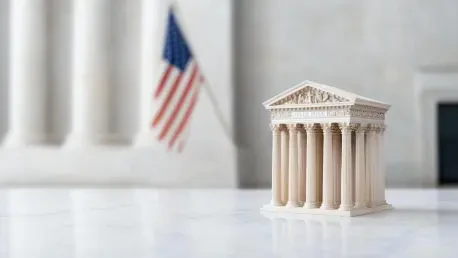In a striking turn of events that could significantly impact the landscape of American immigration policy, the Supreme Court recently ruled on a contentious issue concerning birthright citizenship, challenging long-standing norms and constitutional interpretations. This decision, hailed as a victory for conservative political agendas, mainly aligns with former President Donald Trump’s efforts to restrict birthright citizenship. The ruling prevents lower courts from issuing nationwide injunctions that might curtail Trump’s executive order, thus lighting the fuse for further legal confrontations in lower courts among supporters and detractors of the restriction.
The Supreme Court’s Role in Separation of Powers
Judicial Intervention and Executive Authority
Under the leadership of Justice Amy Coney Barrett, the Supreme Court articulated a clear stance on the scope of the judiciary’s power, especially in relation to executive orders. Appointed by Trump, Barrett delivered the majority opinion, which underscored the necessity for the Court to navigate cases within the bounds of congressional authority while refraining from extensive oversight over the executive branch. This perspective is consistent with a broader judicial philosophy that seeks to preserve the separation of powers by restraining judicial intervention in matters typically reserved for the executive. Critics, however, argue this stance risks sidelining the judiciary’s role in maintaining constitutional checks and balances.
Barrett’s opinion, despite receiving backlash from some of Trump’s supporters for her past rulings, reflects an evolving judicial narrative favoring a limited role in counteracting executive directives. This denotes a shift in how the judiciary perceives its responsibility in adjudicating issues that directly challenge the authority of the presidency. As such, the ruling sets a precedent for future interpretations of executive power boundaries, raising critical questions about the enduring struggle between institutional prerogatives and democratic oversight within American governance.
Impact on Judicial Restraint and Activism
The ruling exemplifies a pivotal moment in the ongoing debate concerning judicial activism versus judicial restraint, igniting discussions around the judiciary’s proper function within the democratic framework. Barrett’s opinion emphasized the necessity to restrict judicial intervention, suggesting that pervasive judicial oversight could disrupt the balance of power and hinder effective governance. This approach, however, has evoked reactions from opposing justices who express concern that such restraint might neglect underlying constitutional principles, especially when executive actions appear to infringe upon fundamental rights.
The decision is indicative of a broader ideological division within the Court, grappling with maintaining judicial independence while respecting established governance structures. This deliberation highlights the inherent tensions in democratic systems as the line between intervention and restraint is carefully negotiated. The ruling thus serves not only as a legal landmark but as a reflection of broader philosophical shifts within the nation’s highest court, influencing how future cases may be approached and adjudicated.
Stakeholder Reactions and Legal Mobilization
Responses from Plaintiffs and Civil Rights Advocates
In the aftermath of the Supreme Court decision, various stakeholders have rallied to adapt their legal strategies, indicating the birthright citizenship issue is far from resolved. Plaintiffs challenging the executive order have quickly pivoted to explore alternatives such as class action lawsuits that could mimic the injunctions initially sought. Coalitions consisting of immigrant advocacy groups, expectant mothers, and several Democratic-led states are actively searching for legal remedies to counteract the implications of the ruling, citing administrative impracticalities and adverse effects on families.
These stakeholders argue that the regional approach, as necessitated by the ruling, poses logistical challenges and inequitable outcomes for affected individuals. Their unified front underscores a shared belief in the inherent value of birthright citizenship as foundational to American ideals, positing that restrictive measures undermine core democratic principles. The broad mobilization of these groups suggests an ongoing resistance and dedication to preserving constitutional rights amidst shifting political tides.
The Role of Political and Legal Advocacy
The Supreme Court’s decision has catalyzed a surge in advocacy efforts, both legally and politically, as organizations and states strive to navigate the new judicial landscape. For many, the ruling represents a call to action, fueling initiatives aimed at challenging the executive order on various legal grounds. The involvement of Democratic-led states in particular illustrates a concerted political effort to uphold birthright citizenship, emphasizing its significance within the framework of civil liberties and equal protection under the law.
Meanwhile, immigration advocates highlight the potential for the ruling to disrupt the lives of numerous families, framing the issue as not only a legal matter but a moral imperative demanding immediate attention. These responses illustrate the ruling’s far-reaching implications, sparking dialogues on the fabric of American identity and the principles underlying citizenship. The broad spectrum of reactions points to a complicated legal battle ahead, as opponents of the executive order seek to employ every available channel to protect the rights they view as intrinsic to the nation’s ethos.
Ideological Divides Within the Supreme Court
Liberal Justices and Persistent Dissent
The ruling has revitalized the debate around constitutional interpretation within the context of executive power, manifesting in stark ideological divides among the justices. Liberal-leaning justices, led by Justice Sonia Sotomayor, voiced their dissent, arguing the Court’s reluctance to intervene jeopardizes essential constitutional safeguards. This dissent stresses the judiciary’s responsibility in upholding the rule of law against executive actions deemed potentially unconstitutional, reflecting a philosophical clash with the conservative bloc of the Court.
Sotomayor’s critique, shared by Justices Elena Kagan and Ketanji Brown Jackson, lays bare the divergent views on the judiciary’s duty to intervene and prevent potential executive excesses. The dissent posits that executive orders immune from judicial review could erode fundamental legal protections, posing a broader threat to democratic principles. Justice Jackson, in her separate dissent, particularly underscored the existential risk posed by unchecked executive power, emphasizing the vital role of the judiciary in preserving constitutional integrity.
The Barrett-Jackson Exchange
In a vivid expression of the ideological tensions, the exchanges between Justices Barrett and Jackson encapsulate the underlying jurisprudential divide. Barrett’s response to Jackson’s dissent was characterized by a firm reiteration of the judiciary’s constitutional limitations in enforcing executive accountability. This dialogue reveals a complex debate over the judiciary’s roles and responsibilities and the balance between ensuring government efficacy and protecting individual rights.
While Barrett’s position highlights the necessity of respecting the boundary between judicial review and executive function, Jackson’s arguments serve as a reminder of the need for vigilant oversight in safeguarding democratic norms. The differing opinions speak to broader questions concerning constitutional interpretation and underscore the challenges faced by the judiciary in maintaining its foundational role. Through these exchanges, the nuances of judicial philosophy in the face of evolving political dynamics are sharply outlined, providing insight into the deeper ideological currents shaping the Court’s direction.
Political Implications and Future Outcomes
Trump’s Policy Agenda and Judicial Restraint
The Supreme Court’s decision constitutes a notable victory for Trump’s political agenda, reinforcing his focus on curbing the judiciary’s capacity to impede executive decisions through sweeping injunctions. His administration’s emphasis on judicial restraint is consonant with the decision, framing the ruling as a triumph over perceived judicial overreach by what he described as the “radical left judges.” This underscores a broader narrative aligning Trump’s policies with principles of democratic governance, wherein unrestrained judicial oversight is viewed as a threat to executive effectiveness.
Through press conferences and public statements, Trump has highlighted the ruling as pivotal in furthering his policy initiatives, aiming to implement measures historically hindered by judicial intervention. The decision is heralded as a precursor to advancing conservative priorities without the looming threat of extensive judicial roadblocks, suggesting a potential shift towards a more executive-centric governance model. Trump’s reaction encapsulates the ruling’s significance in enhancing presidential authority and influences future policy trajectories.
Precedent Setting and Broader Impact
Beyond its immediate effects, the ruling sets a precedent with implications that extend beyond birthright citizenship, affecting potential future interpretations of executive power and judicial intervention. By reinforcing the boundaries of judicial activism and restraint, the decision poses profound questions about the relationship between the branches of government and the broader principles guiding American democracy. The precedent could influence how future administrations and courts approach conflicts involving executive actions and judicial review, potentially redefining the power dynamics within the federal system.
The decision’s ramifications underscore the evolving landscape of constitutional interpretation and governance, marking a pivotal moment in the dialogue on executive authority and judicial oversight. As such, it presents a framework for assessing future legal challenges, particularly those involving contentious policy areas like immigration, civil rights, and administrative law. By examining the decision’s effects on different stakeholders, it becomes clear that the ruling holds significant implications for the ongoing discourse about the future of American democracy and its foundational principles.
Navigating the Complex Terrain Ahead
In a recent development that could reshape American immigration policy, the Supreme Court handed down a decision on the highly debated issue of birthright citizenship. This ruling challenges long-standing norms and traditional interpretations of the Constitution, marking a pivotal moment in legal history. The outcome has been welcomed as a triumph for conservative political factions, aligning with former President Donald Trump’s initiatives to limit birthright citizenship. At the heart of the decision is the prohibition on lower courts from issuing nationwide injunctions that could impede Trump’s executive order. This move effectively sets the stage for intensified legal battles in lower courts, as proponents and opponents of the restriction prepare for renewed confrontation. The spotlight now shifts to how this ruling will influence discussions on citizenship rights and national policy, likely sparking broader debate about the future of immigration law in the U.S., its implications for affected communities, and the balance between executive powers and judicial intervention.









